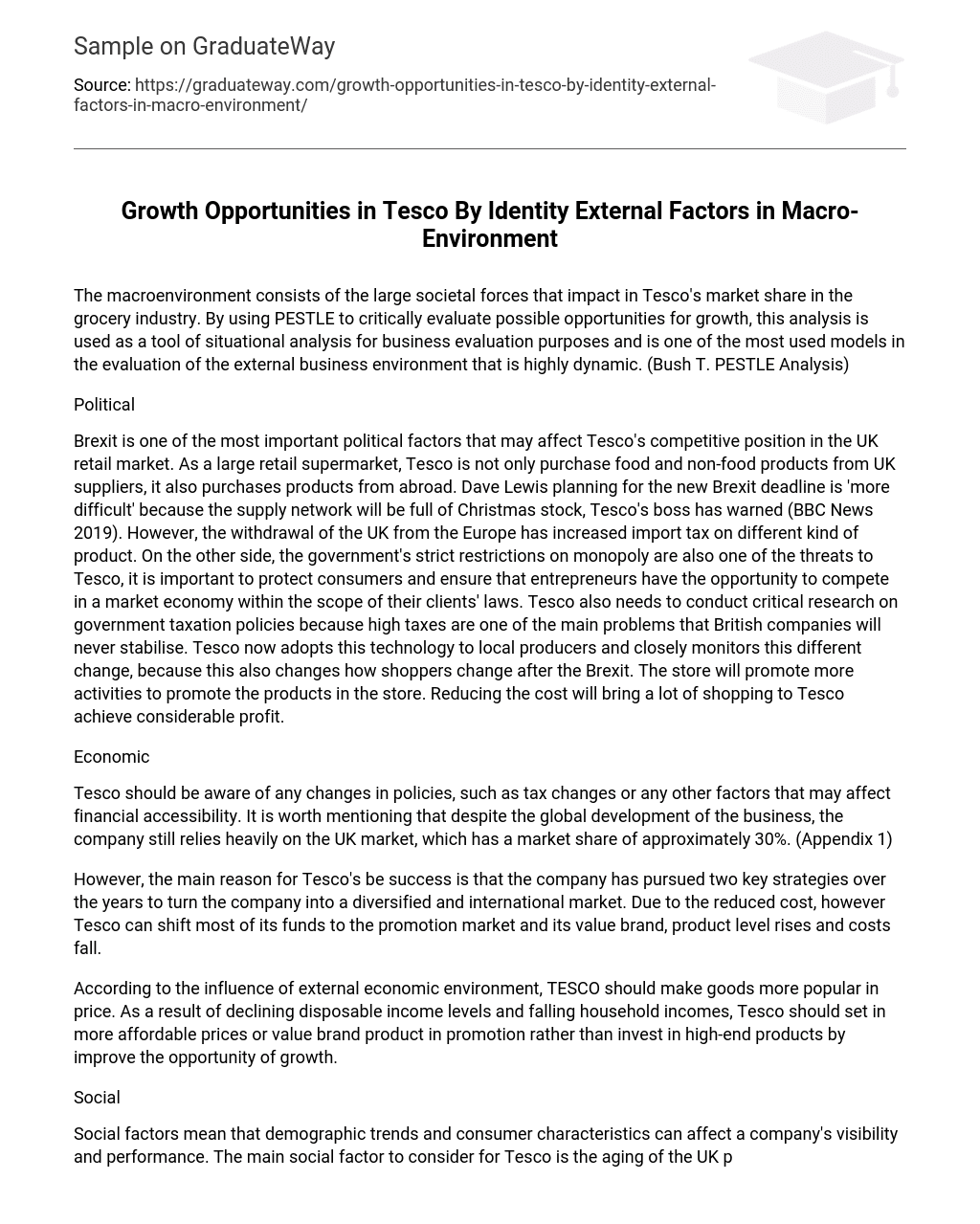The macroenvironment consists of the large societal forces that impact in Tesco’s market share in the grocery industry. By using PESTLE to critically evaluate possible opportunities for growth, this analysis is used as a tool of situational analysis for business evaluation purposes and is one of the most used models in the evaluation of the external business environment that is highly dynamic. (Bush T. PESTLE Analysis)
Political
Brexit is one of the most important political factors that may affect Tesco’s competitive position in the UK retail market. As a large retail supermarket, Tesco is not only purchase food and non-food products from UK suppliers, it also purchases products from abroad. Dave Lewis planning for the new Brexit deadline is ‘more difficult’ because the supply network will be full of Christmas stock, Tesco’s boss has warned (BBC News 2019). However, the withdrawal of the UK from the Europe has increased import tax on different kind of product. On the other side, the government’s strict restrictions on monopoly are also one of the threats to Tesco, it is important to protect consumers and ensure that entrepreneurs have the opportunity to compete in a market economy within the scope of their clients’ laws. Tesco also needs to conduct critical research on government taxation policies because high taxes are one of the main problems that British companies will never stabilise. Tesco now adopts this technology to local producers and closely monitors this different change, because this also changes how shoppers change after the Brexit. The store will promote more activities to promote the products in the store. Reducing the cost will bring a lot of shopping to Tesco achieve considerable profit.
Economic
Tesco should be aware of any changes in policies, such as tax changes or any other factors that may affect financial accessibility. It is worth mentioning that despite the global development of the business, the company still relies heavily on the UK market, which has a market share of approximately 30%. (Appendix 1)
However, the main reason for Tesco’s be success is that the company has pursued two key strategies over the years to turn the company into a diversified and international market. Due to the reduced cost, however Tesco can shift most of its funds to the promotion market and its value brand, product level rises and costs fall.
According to the influence of external economic environment, TESCO should make goods more popular in price. As a result of declining disposable income levels and falling household incomes, Tesco should set in more affordable prices or value brand product in promotion rather than invest in high-end products by improve the opportunity of growth.
Social
Social factors mean that demographic trends and consumer characteristics can affect a company’s visibility and performance. The main social factor to consider for Tesco is the aging of the UK population, which requires increased mobility and flexible delivery methods. Moreover, people are becoming more and more concerned about health. Obesity is another problem in society, and customers pay more attention to their health, Tesco must consider changing behaviors and the demand for organic foods. Base on the opportunity of growth, invest more resources on purchasing in organic product from local suppliers, maintaining low prices and sufficient competitiveness in the context of the global financial crisis can also be a useful way to maintain a positive attitude and visibility among consumers.
Technological
TESCO now uses the latest ‘out-of-the-box’ technology, which not only allows customers to scan the goods and pay instantly on their smartphones, and then complete the purchase with a receipt. Tesco CEO Dave Lewis has mentioned that the technology will be promoted in all supermarket chains. But there is a factor to be consider, that is the company cannot really ensure that consumers will go out without paying. Express stores are also used to test how those shoppers are using this fast-cashless world. According to recent data from the banking industry, the record of borrowing credit cards is surpassing cash payments, so the technology quickly became the most popular method of transaction in the UK (Wood, 2018).
Environmental
Tesco is clearly committed to reducing its carbon footprint by 50% by 2020. In addition, Tesco also minimizes the waste generated by its stores by increasing its social responsibility and customer’s conscience. Tesco has set a goal since 2018. This goal is related to their own brand’s recycled materials. Since 2019, it has divided the list of materials into three colors, red, amber and green, from its own brand items in the production line. These three colors represent different materials. Among the materials recycled by their own brands, the red packaging materials are the most difficult (Barrett, 2019).
Conclusion
According to different market analysis and market theory, as a century-old store Tesco, this simulation strength must be stronger than the existing competitors. For this situation, as a market scholar, it is more important to analyze how to apply different strategies to maintain Tesco’s global market share leadership position. By using Porter’s fire force analysis and Pestel, and then through market philography and SWOT analysis, market scholars can speculate on practical activities to face on new challenges for Tesco.





